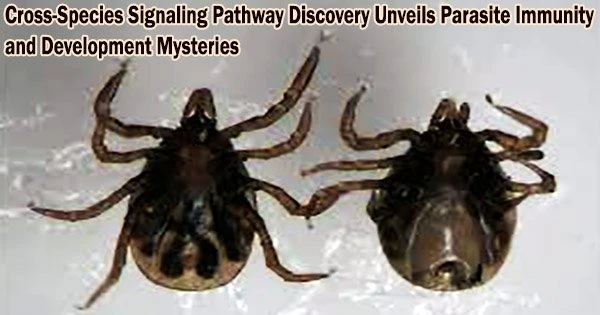The first inter-species signaling route between an arthropod parasite and host, where substances in the blood of a host animal drive the immunity and development of a parasite, has been discovered by research lead by a team from the University of Maryland.
The study demonstrated that a protein from the mouse immune system binds to receptors on tick cell surfaces when ticks feed on the blood of mice infected with the bacteria Borrelia burgdorferi, which causes Lyme disease. This protein signals organs to develop more quickly and triggers an immune response before the bacteria can start to infect the tick.
The study, which was published on January 13, 2023, in the journal Science, identifies a potential target for anti-tick vaccines or therapeutics to prevent the spread of infections like Lyme disease.
Furthermore, the findings highlight for the first time the integration of immunity and animal development as well as the adaptability of an ancient cell signaling system or pathway that all plant and animal cells use to sense and respond to their environment. These findings also offer significant new insights into the evolution of biomolecular interdependencies between species.
“This adaptive flexibility of a conserved cell signaling pathway was surprising,” said Utpal Pal, senior author of the study and a professor in the Virginia-Maryland College of Veterinary Medicine at College Park. “It is remarkable that this pathway that is present in everything from sponges to humans is so flexible it can adapt to accept a ligand (a binding molecule) from another distant species. This tool that everybody has is being used in a way that we didn’t imagine.”
The discovery points to a new field in immunology and molecular biology that is ripe for further investigation and raises the possibility that additional cell signaling pathways have been modified for unique applications in other creatures.
Understanding that this pathway integrates immunity and development has important implications for potential strategies to prevent tick-borne disease transmission. Because if you delete the pathway, ticks with malformed mouthparts cannot feed or transmit disease. But what is also really exciting to me is that we see this sort of early-warning system, where the tick’s immune system indirectly detects a pathogen using an immune response from its host rather than the pathogen itself, accelerating its own development.
Utpal Pal
In order to better understand this understudied aspect of tick biology, Pal and his coworkers looked into tick immunity. In their initial investigation, the researchers gave ticks a blood meal from either a mouse that had Borrelia infection or an uninfected mouse in order to better understand how tick immune systems recognize the Borrelia bacteria.
They discovered by contrasting the two groups that the ticks’ typically energy-producing protein was triggered by the infected blood meal. The protein is associated with a simple signaling pathway called JAK/STAT, which is present in all multicellular organisms.
A particular molecule recognizes something in the environment, as is the case with all biological signaling pathways, and then attaches to a receptor on the outside of a cell wall. This starts a chain of events inside the cell that activates or deactivates a certain gene and causes a response to the external stimulus that was detected.
Assuming that JAK/STAT was triggered by the Borrelia in the infected mouse blood, the researchers isolated the bacteria and injected it directly into ticks to see what molecules were binding with the JAK/STAT receptor.
Surprisingly, the bacteria did not activate JAK/STAT. To find out what did, the researchers removed the Borrelia bacteria from the blood of infected mice and fed the “clean” blood to ticks. The JAK/STAT pathway kicked into action.
The scientists found that a protein found in tick digestive systems served as the JAK/STAT receptor and had developed to bind with the cytokine protein interferon, which is created by the immune systems of mammals afflicted with a bacteria like Borrelia.
Additionally, the JAK/STAT receptor and pathway were discovered to be crucial for typical tick development, even in the absence of an infected blood meal.
The ticks had malformed legs, mouthparts, and digestive tracts after Pal and his colleagues knocked down the expressed gene that makes the JAK/STAT receptor. They also were unable to feed and finish the embryonic cycle in order to grow further.
These findings imply that the protein receptor and the JAK/STAT signaling pathway have evolved in ticks to link immunity and development. When a tick receives the signal that a blood meal is infected, developing quickly is a means to use up those resources before the bacterium gets them. This is because bacteria and ticks will battle for nutrients in the blood of an infected host.
According to laboratory tests, ticks that consumed mouse blood that was not contaminated with Borrelia grew considerably more quickly than those that did.
“Understanding that this pathway integrates immunity and development has important implications for potential strategies to prevent tick-borne disease transmission,” Pal said. “Because if you delete the pathway, ticks with malformed mouthparts cannot feed or transmit disease. But what is also really exciting to me is that we see this sort of early-warning system, where the tick’s immune system indirectly detects a pathogen using an immune response from its host rather than the pathogen itself, accelerating its own development.”
















